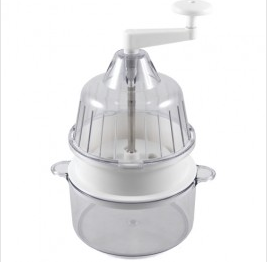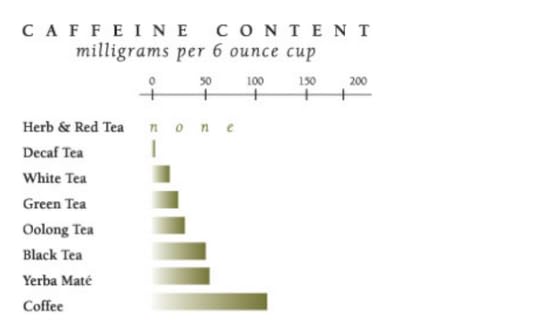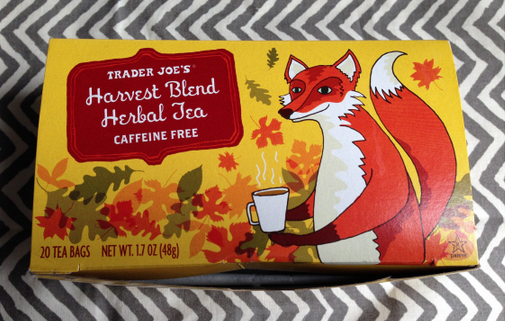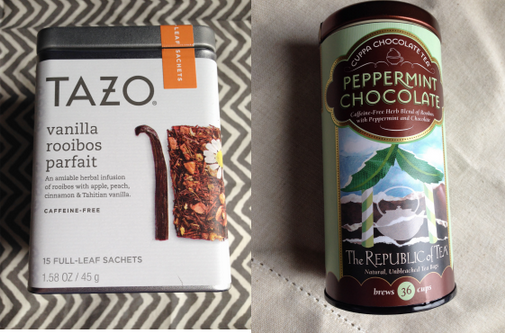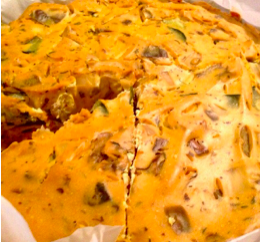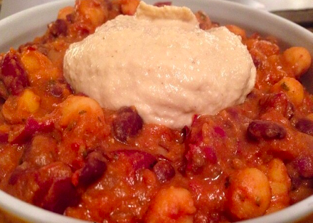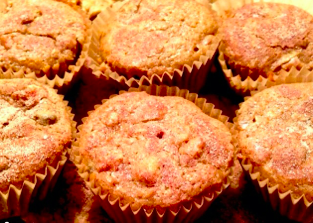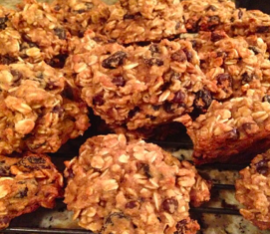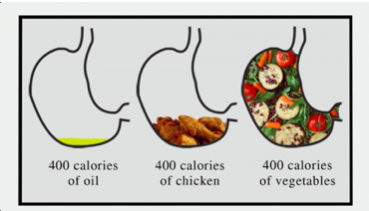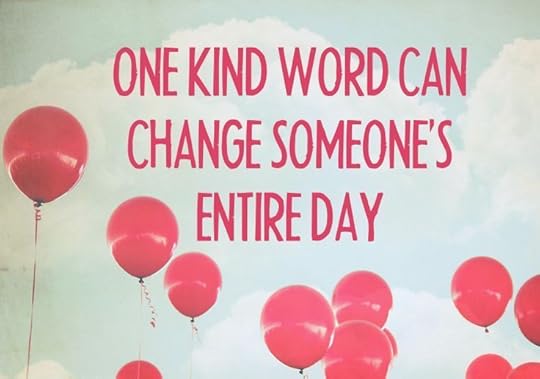Rip Esselstyn's Blog, page 27
May 14, 2014
Thinking Twice About Kitchen Gadgets
When my family and I would enjoy a meal at a particular restaurant, I would always order the same salad. Served in a huge bowl, thinly sliced matchsticks of zucchini, beets, carrots were piled high on top of crunchy romaine lettuce and garnished with tomato wedges. It was so delicious.
I tried so many times to recreate the salad at home but I just couldn’t come close enough. The salad that I made tasted great, but it wasn’t the salad. After many attempts, I finally realized the secret was in the way that the vegetables were cut. Sounds crazy, right?
The veggies on my favorite salad were julienned. This just means they were cut like matchsticks or shoe strings. To save time, and my fingers, I purchased a julienne peeler. It’s one of the neatest kitchen gadgets you can find! You use it the exact same way you would use a regular vegetable peeler. Just run it along the produce item of your choice to produce perfectly sliced pieces!
I’ve always found kitchen gadgets to be interesting but kind of unnecessary because they tend to collect in random drawers after a while. Just like the saying “there’s an app for that,” for any smartphone, “there’s a gadget for that” in the kitchen. If it will help in some part of the cooking process or cut down on my prep time, then I’m all for it. A successful gadget should not only be helpful, but it should make you think of food in a new and exciting way.
Recently, I discovered a gadget that made me rethink a few of my meals—a spiral slicer. This clever little tool turns vegetables into long strands resembling spaghetti noodles. Use them in place of regular pasta to create a completely new meal. You will be pleasantly surprised with the variety of new dishes you can create! Experiment with any firm produce such as potatoes, sweet potatoes, butternut squash, kohlrabi, beets, zucchini, carrots, and even apples! Once you have the noodles, it’s up to you to leave them raw or lightly steam them. The spiral slicer definitely takes pasta to a whole new level.
(Image credit: http://www.smoothieblenders.com/joyce-chen-spiral-slicer-model-coj51-0662.html)
Sometimes eating the same things over and over again can become a little boring. Instead of changing what you’re eating, try changing how you prepare it! Every once in a while, it’s fun to mix it up and trying out some kitchen gadgets is a great way to start.
No related posts.
May 13, 2014
Spotlight on Cholesterol
Spotlight on Cholesterol
We talk a lot about how eating a whole food, plant-based diet can influence your health, but we haven’t written much on specific health topics. This post is the first of what I hope to be a spotlight series where we will look at individual health issues and examine the role that diet can play. The first topic that I’ve looked at is cholesterol. Cholesterol is something that is very important to our health, especially when it comes to heart health, and is also something that we have a lot of control over—much more than most people realize.
First of all, what is cholesterol? Cholesterol is a waxy substance that is found in the body’s cells. Cholesterol is important because it helps to build and maintain cell membranes, and is also important for making hormones and vitamin D. Thankfully, we never have to worry about whether we are getting enough cholesterol because as the National Heart, Lung, and Blood Institute states, “Your body makes all the cholesterol it needs.” However, some people take in external sources of cholesterol through the foods that they eat. All animal products contain cholesterol. Plant foods, on the other hand, do not contain any.
There are two main types of cholesterol: low-density lipoprotein (LDL) and high-density lipoprotein (HDL). Sometimes, LDL is referred to as “bad cholesterol” and HDL is referred to as “good cholesterol.” This is because when too much LDL is flowing through the bloodstream, it builds up along artery walls. This buildup is what causes atherosclerosis (narrowing and hardening of the arteries), which can lead to heart attacks, strokes, and other life-threatening events. But whereas LDL is like the litterbug that throws garbage all over our precious inner environment, HDL is kind of like the garbage truck that collects everything and takes it to the dump. HDL drives through the bloodstream and picks up LDL along its way, eventually dropping it off at the liver to be broken down. The HDL truck can only hold so much garbage though, so when LDL levels are too high, the HDL truck can’t carry all of it, and it ends up piling up in our arteries.
So how does what we eat affect our cholesterol levels? Well, as I said earlier, some foods contain cholesterol while others do not. All foods made of/from animals—red meat, white meat, fish, eggs, milk, yogurt, cheese, etc—contain cholesterol. This makes sense because animals produce cholesterol within their bodies, and when we consume animals and their by-products, we are in turn consuming their cells, which contain cholesterol. People are often surprised to find out how much cholesterol some of the animal products that are usually labeled as “healthier choices” have. For example, a typical steak has around 100g of cholesterol. Chicken breast is hardly much better, averaging at about 93g, and the “heart healthy” salmon comes in around 110g! One cup of cheddar cheese has about 120g, and a single egg has 187g of cholesterol. Plant-based foods, on the other hand, have none. That’s right, none.
The typically prescribed blood level of cholesterol to shoot for is 200mg/dL or less. However, this cholesterol level does not mean that you are free from the risk of having a heart attack or other cardiac event. In fact, in the Framingham heart study—the longest-running study of cardiovascular disease—35% of cases of heart disease were among people who had cholesterol levels between 150 and 200 mg/dL. To truly protect yourself from heart disease, you should try to keep your cholesterol below 150 mg/dL. The best way to do this is to eliminate animal products from your diet, thus eliminating your intake of extra cholesterol*.
Sometimes when people reduce their total cholesterol, their HDL level goes down to a point that concerns some doctors. However, this is not something to get too caught up on. Though there is a correlation between having higher HDL levels and having a lower risk of heart disease, this is not necessarily the case if your total cholesterol is below 150 mg/dL. To put it simply, it makes sense that the more HDL garbage trucks you have, the more LDL garbage that can be picked up—but the less garbage you have floating around in your bloodstream, the fewer garbage trucks you need to collect and dispose of it.
Heart disease is the leading cause of death for both men and women in the United States—one in every four deaths is from heart disease. The good news is that this is very preventable if people make healthy diet and lifestyle choices. As Dr. Esselstyn likes to say, “Heart disease is a toothless paper tiger that need never ever exist, and when it does exist, it need never ever progress.” Heart disease is one thing in life that we have control over. We do not have to live in fear. We can prevent atherosclerosis from ever developing, stop it in its tracks, and in some cases, even reverse it. And all of this begins with cholesterol.
Eat plants and make your heart happy
Tara
*The focus of this post is cholesterol, but to further increase your protection from heart disease, it is important to eat a low-fat diet as well.
Sources:
National Heart, Lung, and Blood Institute (2012). What is Cholesterol? National
Institutes of Health. https://www.nhlbi.nih.gov/health/health-
topics/topics/hbc/
Esselstyn, C. B. (2009). Prevent and Reverse Heart Disease. New York: Avery.
No related posts.
May 11, 2014
Adventures with Ami: A Lesson in Lentils
The basics of learning about plant-strong living is the topic of discussion with the athletes who have come to learn how it can help them improve their health. Class begins with a run down of what we mean by whole foods plant-based foods. I had several examples on the countertop on display. Each food group covered from vegetables to whole grains and beans all the way to herbal teas. We discuss the different types of whole grains and beans I have available. From dried, frozen, canned and ready to eat shelf stable items. Vegetables and fruits, fresh and frozen. We discuss sodium, label reading and options available to them. From dried beans, frozen beans, no salt added canned beans, reduced sodium canned beans and the regular salt heavy canned beans. They are surprised at the differences in sodium between the options available. They have printed copies of the label reading guidelines that we use to learn how to read a food label. The athletes in class ask great questions about each item and name some of the things they have tried. Their concerns range from it being too hard, too expensive and not flavorful enough. I set out to set their minds at ease.
We discussed breakfast options, types of oatmeal and other grains that make a hearty breakfast. Options for traveling abroad that they can take in their suitcase. The Team USA boxers travel extensively to tournaments in all parts of the world. Making plant-based living work for them is highly dependent on what they can access overseas. Taking some plant-strong staples in their luggage can really make it easy. Things like pre-cooked rice bowls we recently discovered at walmart and Whole Foods market are great for packing on a trip. We also found some pre-cooked lentils that are shelf stable at target. Once you’ve arrived at your destination, all you need is some fresh fruit and veggies for a great meal.
Once we’ve covered the basics, we start discussing meal options. Finding plant-strong meals that the athletes are likely to love starts with finding out their favorites. Tacos and burritos are almost always in the top 5 favorites. What I love about this, is the ease in which you can transform a high-fat food based with animal products to a plant-strong wonder! We cover some ways to swap out the meat and dairy of a typical taco or burrito, live fresh sliced avocado, roasted sweet potatoes and salsa. Part of the transformation can be accomplished with lentils.
One of my favorite things to make is lentils. Lentils are cheap, (around 89 cents a pound for brown lentils) versatile, nutritious and easy to cook! I often use lentils as a ground beef substitute. You can use straight lentils or a lentil blend. My favorite recipe is a blend of lentils and grains. The texture is great and the flavor can be modified in as many ways as your imagination allows. I use the following recipe as my base. It makes a large batch. This recipe stores well and can be frozen.
Ami’s Lentil Crumbles Recipe
The basic ingredients include:
1 cup bulgar wheat
1 cup brown lentils
1 cup black lentils/french green lentils
spices to taste
6 cups water
Combine Lentils and bulgar wheat with the water/or broth. Add any seasonings being used, in addition to onions or other vegetables you might be using in your recipe.
Cook the Lentils: Bring the water/broth to a boil over medium-high heat, then reduce the heat to a low simmer. Cook, uncovered, for 20-30 minutes. You may need to add a bit more water to be sure you have enough liquid for your lentils to soak up depending upon your recipe. You don’t want soupy lentils though, so only add a little water at a time. Test the lentils for tenderness to determine when done. The lentils should be tender in the center. You want to let the lentils rest for about 20 minutes after cooking. This creates a thick and crumbly mixture.
With this basic recipe, you can make lentil crumbles to fill your tacos, top your nachos, make BBQ sandwich filling or layer into your lasagna. All you need to do is change the spices. Here are some of my variations:
Basic no-beef style:
I like the texture of black (caviar) lentils if you can find them in addition to the bulgar wheat and brown lentils. I use garlic, a chopped onion, black pepper and Bragg’s Liquid Aminos to flavor my basic beef style lentils. You can also use veggie broth in place of all or some of the water for a richer flavor. Add your seasonings to taste. Start with a little, as you can always add more. Stuff peppers or zucchini with this blend along with some sliced mushrooms.
Taco crumbles:
I use my basic ingredients and use cumin, chili powder and cayenne pepper as my seasoning, along with Bragg’s Aminos and diced onions. You can make your taco crumbles as spicy as you’d like by adding more cayenne. Experiment with the levels of spice you use.
Italian crumbles:
Starting with the basic ingredients, I add garlic, basil, oregano and black pepper along with Bragg’s Aminos. I like to add diced onions and sliced mushrooms or green peppers too sometimes. This blend is perfect for layering in a lasagna or over whole wheat pasta with diced tomatoes.
BBQ crumbles: make the basic beef recipe, adding low sodium BBQ sauce and a little liquid smoke. Use rosemary, sage and thyme for a Thanksgiving meal flavor. Or try a Moroccan spice blend to spice them up or Herbs De Provence – one of my favorite spice blends that contains: French thyme, savory, fennel, rosemary, marjoram, basil, lavender and tarragon. Have fun trying new variations, swap out ingredients and make your own creations!
No related posts.
May 9, 2014
10 Tips on Dealing with Depression
I don’t remember when I first started to feel sad. It was pretty early on, and I knew when I was young that it wasn’t a particularly good feeling to have, at least not as often as I felt sad. Later I’d come to find out this was depression. There have been a lot of things in my life in which people would say “well it makes sense you are depressed!”
But for me it’s a little more than that. There has been times where the depression just feels like it takes over my life. I don’t talk about it much, and I don’t like to dwell on it. We get a lot of e-mails about depression and plant-strong eating. While I can say that eating plant-strong has perhaps helped in this area of my life, I’ve found that there were a lot of other things that I needed to make a daily practice to help even more.
1. Talk to someone.
I always felt so ashamed about getting help. I think that is part of having depression. You start to tell yourself that you shouldn’t “need” help, that something is messed up with you that you have to go talk to someone. But for me, this is a huge part of my learning tools to get through and to get better. Personally, I’ve found the cognitive therapy approach to be helpful, but you could be different. Find someone that you feel comfortable with and who is kind.
2. Move.
I don’t know if I can stress this enough. Moving your body is a KEY part in dealing with depression. It psychologically tells you through something physical that you are ok, that you are in a sense “moving on”. When you move your body your brain knows that things might be ok, because you are not “down and out”. Whatever you can do, do it. If that’s 10 minutes a day, so be it. For me some cardio and Bikram Yoga has been VERY beneficial. Yoga has been surprisingly helpful for me. It’s difficult, which means I can’t really concentrate on anything but yoga, it is physically taxing, so my brain gets those cues that things might be ok, it is satisfying to accomplish something that many people find to be very difficult.
I know that the last thing people want to do when they are depressed is to get out and move, but I promise that if you start making it a small habit it can help improve things over time.
3. Meditation.
I’ll admit, I’m really bad at this one. Getting my brain to feel still for any length of time can prove very difficult. I just started with a minute of intentional breathing instead of thinking “I need to meditate for 30 minutes”. So for now, I just sit still for a minute and breathe in and out deeply.
4. Healthy eating.
For me, healthy eating has made a really big difference in my depression. Personally, when my blood sugar was out of control, when I had nerve damage in my legs, when I felt horrible ALL the time, it really made me feel more and more depressed. Once I started eating healthier, and those issues went away, I started to make a lot of improvements in the depression. I know that it is not always easy, we feel depressed, we want to eat food that will harm us, but try starting with a healthy breakfast and then go from there. Starting off with one good meal is a great way to start the momentum to try for more later.
5. Writing
I’m not sure if this is everyones cup of tea, but for me writing has been a great outlet for me. I don’t share what I write, I just write and let the words flow, I get it all out. I think (for me) just being able to think through what is going on in my life does a lot to help – and something about writing it out makes it feel like I’m dealing with it, and acknowledging the issue.
6. Changing your space.
Sometimes I hop in the car and I just go somewhere else. A coffee shop, a book store, a park, a movie. Sometimes it just helps to change the environment you are in.
7. Call a friend
This is also something I’m really bad at. Admittedly, I don’t like to tell people when I’m feeling really down. I have learned, I don’t need to go into any details at all, sometimes just the act of calling someone to chat is really helpful. So I’ll call someone or chat with someone online about our regular lives, it ends up going a long way.
8. Help others.
I’ve always found that volunteering to help someone else not only is a great help to that person, but can be a great help to you. My favorite place to volunteer is at nursing homes. The people there will probably never know how much they have helped me and changed my life. People who are older than me can always seem to offer a perspective on life that no one else can. I have a standing phone call with a friend who is in her 80′s. It’s one of the highlights of my entire week. She tells me stories about her life, offers wisdom only someone in their 80′s can offer and is always happy to have our calls. There are tons of places you can volunteer – animal shelters, children hospitals, nursing homes and more.
9. Clean a room.
This might just be me – but something about really deep cleaning a room or organizing a space has really helped me lift from depression. I think for me, it tells my brain that things are going to be just fine, if my closet is organized, then life can’t be all that bad. So I tackle a room or a space in my house, deep clean, de-clutter, get rid of stuff.
10. Take a class.
Find a class you are interested and sign-up! I’ve been back in school to study nutritional science and I will soon start my PhD track for psychology. It has been such a positive thing for me in my life – having the challenge of studying and learning, having some interaction with students and teachers has definitely made a difference for me. But, beyond that there are lots of other classes that I take. Look online for courses (many free), check out MIT’s free open classes that you can audit (I’ve taken several of them and have loved all of them). Go to a local community center and take a class on pottery or how to make jewelry or how to do some basic car maintenance. Take a yoga class, or a water aerobic class. Getting out, learning a new skill can go a long way in helping with the days in which things feel like they are too much.
Depression is a complicated and difficult thing to go through. I know that somedays it feels like it will never lift. Know that you are not alone in the battle, and that over time, things will start to get better.
No related posts.
May 8, 2014
Trading Up!
Trading Up
I have something to admit: I used to be hooked on diet pop. It’s crazy to think just how many cans or bottles I would go through in a day. And don’t even get me started on the free refills at restaurants. The waiter or waitress would fill my glass up at least three times during a normal restaurant visit.
I used to have these moments throughout the day where I just needed something. That something was a diet pop. I craved the sugary sweetness that no other drink could satisfy. Even the sound of the can opening offered some sense of satisfaction.
It’s been years since my last run-in with pop, and for that I am grateful. Kicking the pop habit wasn’t easy. In fact, next to avoiding vegan sweets, it was the hardest thing to give up. In the end, it was all worth it because if I hadn’t given up pop, I would not have discovered how much I enjoy tea. Only after giving up pop did my interest in teas grow.
My family is full of tea lovers. If you can believe it, my grandma started drinking tea when she was about 5 years old. She passed on the tradition to my mom who then passed it on to me. When I was younger and most kids my age were drinking apple juice, I was drinking tea.
Besides being a great substitute for coffee, or pop in my case, tea is known throughout the world for having wonderful health benefits. This is especially true for the naturally caffeine free variety called rooibos. Also known as red tea, it is known to provide relief from many things such as headaches and allergies.
Consumed hot or cold, tea is quite the versatile drink. The same tea served hot may taste completely different cold. A cup of hot tea in the winter is wonderfully comforting, especially on a blistery snowy day! In the summertime, a nice glass of iced tea will surely quench your thirst after a long day in the sun.
A part of being plant-strong is giving up caffeine so it is important for you to know that not all teas are caffeine-free! The good news is that all teas are lower in caffeine than coffee. Herbal and rooibos teas are naturally caffeine free, so you’re always safe with those. Other than that, make sure you read the box to make certain it is caffeine free.
This picture from The Republic of Tea’s website is a great caffeine guide for tea
source: http://the.republicoftea.com/library/tea-information/tea-and-caffeine/
A few of my favorites:
Tazo Vanilla Rooibos Parfait, The Republic of Tea Peppermint Chocolate, Trader Joe’s Harvest Blend
In my cabinet:
Trader Joe’s Pumpkin Spice Rooibos
Trader Joe’s Well Rested
The Republic of Tea Hot Apple Cider Tea
The Republic of Tea Blueberry Bundt
The Republic of Tea Strawberry Chocolate
The Republic of Tea Banana Chocolate
The Republic of Tea Red Velvet Chocolate
Mighty Leaf Chamomile Citrus
Mighty Leaf African Nectar
Traditional Medicinals Raspberry Leaf
Allegro Fine Tea Thirst Tamer
Allegro Fine Tea Relaxing Chamomile
Allegro Fine Tea Happy Tummy
Numi Holiday Herbal Chai
Zhena’s Gypsy Tea Caramel Chai
World Market Tropical Rooibos
Harney & Sons Fine Teas Pumpkin Spice
If you’re just starting out on your plant-strong journey and having a hard time giving up a certain drink, I encourage you to give tea a try. Who knows, you just might like it! To all those tea drinkers out there, I hope this post will encourage you to experiment with different varieties.
-Katherine
No related posts.
May 5, 2014
Adventures with Ami: Plant-Strong Athletes
It’s been a busy week here. We’ve had our first workouts at the boxing gym . The kids arrived, activities started, smiles all around! They love the new gym space, the new equipment and the big bowl of fruit we have for them each day. I had the opportunity to have many conversations with the kids about healthy snacks. Each day the bowl is empty at the end of the night. They consumed 40 pounds of apples collectively this week in addition to 4 pounds of bananas. This warms my heart. The enthusiasm the kids have is contagious. I am so looking forward to watching them learn and grow.
This week also brings one of the Team USA boxers to stay with us for a few weeks. He’s here for training and to learn about plant-based nutrition. We will have several sessions, a mini immersion of sorts, covering the benefits of plant-based eating, calorie density, cooking, shopping and eating well while traveling. Athletes, like the rest of us, simply need a wide variety of plant-based foods to thrive. Several of the athletes from our program will be joining us as well, in addition to another Team USA Boxing member. Our plant-strong camp will help them get started on their journey to better health.
Our Plant-strong camper is young, in great shape and within a couple of pounds of his ideal weight. He wants to feel better, recover faster and prevent health issues related to the Standard American Diet. We started off this week by discussing favorite foods. It’s important to know what foods someone loves so we can work on finding plant-based alternatives. In this case, shrimp, Italian food and Mexican food. Though I won’t be seeking out a mock shrimp product for him, the rest I can do easily! We also discussed foods he doesn’t like at all like onions and mushrooms. He does like spicy food though, I discovered. All of this matters. So does knowing things like if he likes to eat breakfast, what his go-to snacks are now and what he sees as his trouble spots. In his case: salt. He loves salt!
We will start on Monday with some plant-strong basics. What makes something plant-strong? The benefits of following a plant-strong plan and we’ll cover the guidelines for following Engine 2. We usually watch Forks Over Knives and the Engine 2 Kitchen Rescue as well. Our next stop is the grocery store. We’ll go with our Engine 2 Extra Pantry list in hand. At Engine 2 Extra, we have many easy guides and ebooks available for members. The pantry list is one of my favorites. With the ingredients found on the pantry list, you can make just about any kind of meal. The things I stock in my kitchen all the time are there. It’s easy to just open the refrigerator and pantry and create a meal from what I have on hand that way. We will also take the label reading guide that UC Davis created using Jeff Novick’s label reading guidelines.
Watch for my next blog, covering our adventures at the market and in the kitchen as we shop and learn to prepare easy plant-strong meals athletes and non-athletes alike. We will be building easy meal bowls, making burgers, cooking in bulk and making food and snacks that can travel well.
No related posts.
April 23, 2014
Why It’s So Worth It To Go Oil-Free
Why It’s So Worth It To Go Oil-Free
Stop eating animal? Okay. Cut out dairy? Sure. Eat more fruits and veggies? You got it. Stop eating oil? Seriously?
This is what went through my mind every time I tried to stop eating oil. I would get myself on board with the idea, knowing how it would benefit my health, and then a few days or at most, a few weeks in, I would give up. I told myself that I have already cut so many other foods out of my diet that I cannot possibly give up oil, too. Plus, oil is in EVERYTHING. How will I cook and bake? How will I enjoy my food? What on Earth will I eat?
I have gone back and forth with this concept for almost a year. The first time I gave up oil, I did so under the assumption that taking this source of fat out of my diet would help to clear up my acne. And it did. I also shed a few extra pounds effortlessly. However, living at school and cooking for myself made it easy to live without oil. When I came home for the summer, I did not want to cook myself a separate meal from the rest of my family every single night. So, little by little, I allowed oil to creep back in to my diet, eventually taking over almost every meal for the rest of the summer.
Almost immediately, I was back on my skin medication and I had gained back the weight I had lost, and then some. But it was right around this time that my mom and I were lucky enough to attend the Farms 2 Forks immersion at the Esselstyn Farm! Within the first few hours, I listened to Rip Esselstyn, Dr. Campbell and Dr. Esselstyn all speak about the benefits of a low fat, plant-based diet. They sold me. I was ready to switch my olive oil to balsamic vinegars and be done with it.
However, it was not long before I let vegan recipes, coconut oil and vegan meat and butter alternatives get the best of me. I love to bake and I love to cook and I convinced myself that my meals wouldn’t be as satisfying and my baked goods would not be as delicious without processed fats. I was sorely mistaken. In no time, I was back to feeling lousy, and knew that I had to make a conscious effort to remove oil from my diet. In the New Year, I became more mindful of oil in my foods, trying hard not to purchase any foods containing oil, and to leave it out of everything I cooked and everything I baked. It wasn’t so bad.
I am happy to say that I am now 100% oil-free. I feel lighter, more alert and definitely more nourished. I have not refilled the prescription for my skin medication in weeks and I have lost weight effortlessly. My parents are also oil-free, they are also losing weight and my father, who has suffered with sleep apnea for his entire adult life, is now sleeping soundlessly. For me, giving up oil went hand in hand with straying from processed foods. It is so much easier to stock up on fruits, veggies, greens, legumes, beans and whole grains then having to read label after label of your favorite foods, crossing your fingers that they, too, are oil-free.
I no longer feel listless and tired, and I no longer have a “mind-fog” as I go through my day. I attribute all of these feats to purging my diet of oil and oil-filled foods. I am still cooking every meal of the day and baking all of the time. It is definitely not as hard as it seems! It is so easy to cook with a little bit of water instead of oil, and add bananas, apple sauce or flax meal to baked goods instead of the coconut oils, vegan margarines or butter alternatives. This is the best thing I have done for my health, my body and my mental clarity since I have gone plant-based. Here are some photos of my adventures in plant-based, oil-free cooking & baking!
Tofu Veggie Quiche Three Bean Chili topped with oil-free hummus
Apple Cake Muffins Oatmeal Raisin Cookies
But what is it about oil that makes it so controversial? The Mediterranean Diet swears by the health benefits of oils in moderation, and bakers love coconut oil for the health benefits, texture and taste. Plus, who doesn’t cook with olive oil? Almost every recipe advises you to add it to the pan to sauté foods, or add it directly to the foods for a beautiful texture and delicious flavor. But oil is fat, and adding fat to your food, cooking with it and eating it in pre-packaged foods can be very detrimental to your health and wellbeing.
Dr. McDougall states that, “the fat you eat is the fat you wear.” And after eliminating animal foods, oil and concentrated forms of oil, as well as the few high-fat plant-based foods, are all that are left in the diet. Oil is highly processed, pure fat and low in nutrients but exceptionally high in calories. Dr. Esselstyn, a great proponent of this oil-free, plant-based lifestyle, writes, “NO OIL! Not even olive oil, which goes against a lot of other advice out there about so-called good fats. The reality is that oils are extremely low in terms of nutritive value. They contain no fiber, no minerals and are 100% fat calories. Above all, they contain saturated fat, which immediately injures the endothelial lining of the arteries when eaten. It doesn’t matter whether it’s olive oil, corn oil, or any other kind of oil.” More insight on this matter is detailed in Dr. Esselstyn’s book, Prevent and Reverse Heart Disease.
If the benefits of a low-fat, nutrient-dense, plant-based lifestyle can truly prevent and reverse heart disease, why isn’t everyone trading their oils for applesauce and vinegar and embracing this lifestyle? Because oils have been marketed as “healthy fats” for years, and all of this marketing has lead to a job well done by the brands and companies that sell tons and tons of cooking oils each year.
In regard to coconut oil, Jeff Novick, MS, RD, states that, “in spite of having no nutritional value, it is regarded by many as a health food.” One hundred calories of coconut oil has 11.6 grams of fat and 10 grams of saturated fat, over 90% of the total fat in this oil. Those are the only nutrients in coconut oil. Sugar has more nutrients. Coconut oil supplies no carbohydrates, essential fats, vitamins, minerals or proteins. So, it is contributing nothing to the diet except fat, and quite a lot of it. Overall, coconut oil does have some antimicrobial properties, but besides that, it can only offer you fat.
This diet and lifestyle is not fat-free. There is fat in plants, vegetables, fruits, starches, beans and whole grains that we consume, and that is enough. There are also high-fat plant foods, such as nuts, seeds, and avocados. You do not need to add too much of these foods to your daily routine, because even though they are plant-based, they are still high in fat. If you are looking to lose weight or if you have heart disease, Engine 2 Diet and Forks Over Knives recommend that you greatly reduce the presence of these foods in your diet.
Fish oil is another highly debated topic. By consuming fish oil or fish oil supplements, you increase the levels of eicosapentaenoic acid, or EPA, an omega-3 fatty acid popularized for its health benefits. However, Dr. McDougall writes that consumption of fish oil can have adverse effects on health, leading to increased levels of “bad” cholesterol (LDL) in patients with already high cholesterol, leading to worsening diabetes in some. People who take fish oil supplements are also at an increased risk for bleeding. Dr. Esselstyn writes that fish oil is not essential and that it would be hard to become deficient in these omega-3 fatty acids if you are consuming flax seed meal and leafy greens a few times daily. Research suggests that people on plant-based diets suddenly become efficient in manufacturing omega-3s in the body.
In his article about caloric density, Jeff Novick states that by lowering the caloric density of your diet, you will automatically consume foods higher in nutrient density. For example, fruits and vegetables have 60-420 calories per pound and beans and lentils have 310-780 calories per pound. On the other hand, sugars, including agave and maple syrup, have 1,200-1,800 calories per pound, nuts and seeds have 2,400-3,200 calories per pound and, finally, oil has a whopping 4,000 calories per pound. It is so much easier, and so much more satisfying, to nourish the body on a diet based on beans, greens, fruits and grains, as opposed to sugars and fats.
In the end, get rid of the oil. It tastes good, but it will not nourish or support your body, and it will only leave you craving more fat. Experiment with oil-free cooking and baking! Be positive and know that you will still enjoy your food and baked goods, while being 100% confident that you are doing the right thing for your health and your body. Here are some great resources to get started (or continue) with oil-free cooking and baking:
Cooking Without Oil: Cathy Fisher: http://engine2diet.com/the-daily-beet/guest-post-cooking-without-oil-by-cathy-fisher/
Substitutes & Techniques for Oil-Free Baking/Cooking: http://fatfreevegan.com/substitutes-and-techniques-for-fat-free-cooking/
Enjoy!
Resources:
http://engine2diet.com/the-daily-beet/no-oil/
No related posts.
April 21, 2014
Adventures with Ami: Pears and Geometry
We have been working really hard to get our youth program set up in our new gym space. Long hours, hard labor, joyful work, all of it (for the most part) knowing that we are almost ready to open the St Louis All City Boxing gym doors. One of our young athletes came by with one of our coaches to see our gym space last week and we had the best conversation!
I gave him a tour of the space, explaining what each part of the gym would be used for. Where the equipment would be, where the tables and chairs would be for tutoring, and the big bowl of fruit we’d have for snacking on right after school. We talked about having healthy snacks, the importance of eating good food and what we have planned for our nutrition program. The young man thought for a bit and said, “I like pears…and peaches!” He told me all about a local farm where he had gone on a field trip, twice and the enormous peaches they grow on the farm.
We also discussed gardening, building raised bed gardens, vegetables, and cooking. He shared that he doesn’t like tomatoes, but he likes green beans! We also chatted a bit about the tutoring program we are planning. How we plan on hitting the books for an hour before fitness and boxing at our gym. We talked about school, his love of geometry and the possibility of growing watermelon. He helped me figure out how many watermelon plants we could plant in a raised bed that was 6′ x4′.
It was a wonderful conversation with a bright and talented young man. It is these moments that I am looking forward to most. I love boxing. Our gym is going to be amazing. The kids though… the kids are just incredible. They are all looking forward to having a gym of their own and being part of the community we are creating. Having the opportunity to create this program is a dream come true for us. Being able to share our love of plant-based nutrition and boxing with the young people in our program is going to change the lives of everyone involved.
The success we have had with our Go Fund Me drive has helped us put together some of the equipment that we need to get started. We can rest easy knowing that the safety equipment that each athlete needs to participate has been purchased. We are working on purchasing our protective flooring, a computer for the tutoring room, uniforms for competing in tournaments and providing healthy snacks, like pears and peaches on a daily basis for the kids. We don’t anticipate having our full nutrition program operating until 2015. Until then, a big bowl of fruit will greet the two dozen kids every day upon entering the gym.
It’s been a fantastic month. One of our athletes is headed to the Golden Gloves Tournament of Champions in Las Vegas next month. In addition to that news, Cam F. Awesome, our plant-strong boxer won another gold medal in international competition in Poland this week! We also hung our first piece of equipment today! Our basement space is now officially our gym! We are all pretty excited at this milestone. Thank you all for your support, kind words and encouragement in this endeavor. It means the world to me to be able to share this adventure with you!

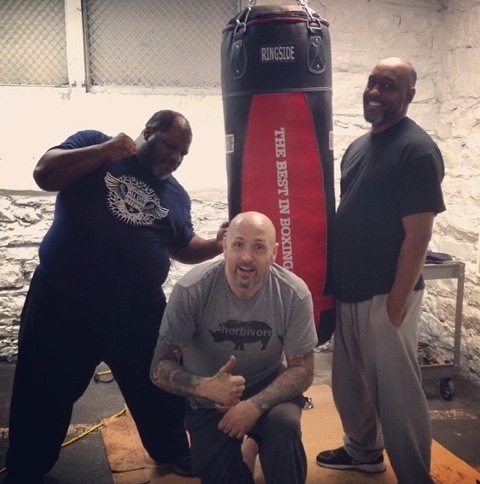
No related posts.
April 17, 2014
Plant-Strong Easter Menu

Easter is around the corner and many of you are preparing for your Easter brunch or dinner. We have some tips, recipes and suggestions on how to make this Easter a healthy one.
Plant-Strong kids:
Easter egg hunts do not have to include eggs filled with candy. This year change it up and fill your eggs with stickers, dried fruit, little toys, coins, or maybe have one egg that has a slip of paper that says ‘special gift’ and give one nice gift that your child has been wanting.
Speaking of eggs, if you’d rather not dye eggs, why not head to the craft store and pick up wooden or ceramic eggs instead! Have an egg-painting party. You can also pick up some other non-food crafts while you are at the craft store.
Easter brunch:
We love baking a batch of mighty muffins for brunch! Everyone loves them, and they are nice to have for people to snack on after brunch as well. Here is the recipe:
Makes 6 large muffins or 1 enormous loaf.
Prep-time: 15 minutes
Cook time: 45 minutes
Preheat oven to 375 degrees
Ingredients:
6 brown bananas, lightly mashed (leave some chunks)
1 large apple, grated
¾ cup water
3 cups oat bran
1 teaspoon baking powder
½ teaspoon salt
¼ cup walnuts, chopped or halved
¼ cup raisins
4 tablespoons sweetener
Juice of 1 lemon
Instructions:
Mix wet and dry ingredients in separate bowls. Squeeze the juice of one lemon onto the combined apple and bananas
Combine wet and dry ingredients into one bowl.
Pour into lined muffin tins or use silicone muffin bake ware and bake for 45 minutes or until golden brown on top.
Variations:
Bake the batter in a loaf pan, and enjoy hearty slices instead of muffins.
Add three thinly sliced pears or 1 cup of 70 percent pure cocoa chips to the batter.
More ideas for brunch:
Zucchini Frittata from Fat Free Vegan
Basic tofu scramble from Happy Herbivore: You can do almost anything you like to tofu scramble, add in beans, salsa, veggies!
French Toast: We actually like to bake our french toast now! And you can make stuffed french toast by adding lots of cooked berries.
Lunch/Dinner ideas:
First of all, be sure to have a giant salad on the table. Throw in tons of vegetables and even some grains and beans.
Sweet Potato Lasagna: This is our favorite!
Fat Free Vegan’s Meatless Loaf
Dessert:
Poached Pears in raspberry sauce.
What is on your Easter menu?
No related posts.
April 15, 2014
A Bag of Potatoes, Microwaves and Being Kind
A few weeks ago I got this e-mail:
“Hello, My name is Nancy I am 74 years old. I live on a fixed income and I am disabled. I have diabetes (type 2), and a bad heart. I am very limited in what I can do. I can’t cook anymore, or cut up vegetables. I want to be healthy, please help.”
My response to Nancy was that I was so proud of her for wanting to become healthy, and that despite that she has some difficulty getting around, chopping vegetables or even cooking, I was sure we could help her figure something out.
I went through ways that she could eat healthier, despite her limitations. First, we found a grocery delivery service for her that doesn’t charge over a certain amount. Second, we picked out things that she would not have to prepare. It was mostly all frozen food, oatmeal, some cereals, all things that she only needed to open a bag and heat up in a microwave.
Even some of that was hard for her. The easiest things were the steamed bags (frozen and not frozen). We found that steamed brown rice and steamed (packaged) potatoes were the most simple things for her to prepare, and provided a good source of calories for her as well. She didn’t have to wash the potatoes, poke holes in them or even put them in a microwave safe dish, same with the frozen brown rice.
After 2 weeks Nancy wrote this to me:
“Well dear, my blood sugar in the morning was 132. I am happy, because when I wrote to you before it was always near 250 when I woke up. I think I’ve lost some weight, because my pants are a little loose. I am glad that being healthy isn’t as hard, and I don’t have to chop up lettuce and carrots all day long.”
Nancy’s story is not unique. There are 1000′s of people who have a hard time either being able to prepare food, or sometimes being able to afford it. And, beyond that, there are 1000′s of people who just need eating healthy to be easy. They need it to be a no-brainer. For some that means being able to prepare a meal without chopping, dicing, processing, following a recipe. For some that means that they just need to throw something in the microwave for a few minutes, and not even concern themselves with turning on an oven. It would be nice to think that every persons situation is perfect and ideal. That we could all just go and pick our vegetables from our farm out back, that we could spend time preparing, cooking, chopping to make gourmet meals. And maybe, that is your situation, but for most that is not what they are faced with.
When I started eating this way I was morbidly obese with out of control diabetes that had lead to some serious complications in my feet and legs. I was tired most of the time, and I was severely depressed. It took me so much effort to even want to get out of bed most mornings. I needed this to be simple. For a while, I stuck to my microwaved oatmeal, microwaved brown rice, cans of beans and vegetables.
Now, there are people that might harshly judge me for doing that. “You use a microwave?!” “You used canned beans?!” “You didn’t check to make sure every thing you bought was gmo free and organic?! You didn’t eat local?!”
The reality is, that all of that potentially saved my life. The microwave, the non-gmo/non-organic food, the cans of beans. I still got well. I did not become more sick. I was virtually off all my insulin (over 200 units per day), I was losing weight, my blood pressure dropped into a normal range, an infection that could have cost me part of my leg cleared up, all while consuming things that many people would gasp at.
And you know what? I still use a microwave, I still used cans of beans, I use TONS of frozen vegetables. Sometimes my fruit and vegetables are non-gmo/not organic. And guess what? I’m still getting healthier and healthier.
Recently we ran an article about how to shop plant-strong at Walmart. It was written by one of our brilliant interns. I was honestly surprised by the backlash we got from the article. It was shocking to see how many people were so quick to judge those who shop and work there.
And then we got this e-mail:
“I’m an single mom with 2 young kids. I work at Walmart, full time, and have been there for 11 years. I really like my job actually. Yes, money is tight, like it is for anyone else. I’ve applied to other jobs and they all pay less than what I’m making. I was really upset when I read the comments by your fans on the article on Walmart. No, it’s not perfect, but it’s a job, and I’m fortunate, many people don’t have one. Your article was very helpful to me. I’m obese, and I have type 2 diabetes. I have been struggling to know what to buy, and I work at the store! For the first time in 11 years I was able to go and shop and buy all healthy food. I know that people don’t like Walmart, but for me that is my only option. I wish I wasn’t made fun of and mocked for shopping or even working there. Thanks for knowing that not everyone can afford to shop at fancy stores, I think I can get healthy just fine shopping at Walmart still, even though people might hate me for it.”
I was really sad to see this e-mail. I spent a few years working with people who were struggling. I was always shocked by the harsh judgement those people would get from society. Honestly, for the most part they were doing all they could to make a better life for themselves. Like my family, when I was growing up. We struggled greatly, despite that my father worked a few jobs. We relied on help from others, a lot. I can assure you that the number one priority for my parents was not to shop at fancier stores and to make sure all of our food was organic, it was simply to feed us so that we did not starve.
And the reality is that a lot of Americans are in that situation. In order to change the health of this country it is going to take ALL sides. It’s going to take people knowing how to shop at Walmart. It’s going to take people knowing how to make a perfectly healthy meal in a microwave. Over the next several decades we can start dealing with some of the other issues. But those issues, seem to be more of distractions at the moment, rather than things that will actually solve our health crisis.
We need to focus on the bigger picture for a little bit. We need to practice kindness in the way we interact with others. If someone shops at Walmart, doesn’t use all organic food, can’t shop at their farmers market, is unable to chop vegetables, doesn’t have an oven, they should not be made to feel like they cannot be healthy.
There is a great analogy I used to hear a lot in Church when I was growing up. It went something like this:
A man was stuck on his rooftop in a flood. He was waiting for help. Soon a man in a rowboat came by and the fellow shouted to the man on the roof, “Jump in, I can save you.” The stranded fellow shouted back, “No it’s ok, I’m waiting for something better to come along!”
So the rowboat went on.
Then a motorboat came by. “The fellow in the motorboat shouted, “Jump in, I can save you.”
To this the stranded man said, “No thank you, I’m waiting for something better to come along!”
So the motorboat went on.
Then a helicopter came by and the pilot shouted down, “Grab this rope and I will lift you to safety.”
To this the stranded man again replied, “No thanks, I’m waiting for something better to come along!”
So the helicopter reluctantly flew away.
Soon the water began to rise and he didn’t have a way out, he couldn’t figure out why nothing better had come along – when a voice whispered “you were sent a rowboat, a motorboat and a helicopter! What were you waiting for?!”
The point is, that how we solve this health crisis might not look what we want it to, it might not be pretty, or perfect, or even all at once. Let’s look for ways that we can solve things, help people, even if it is not the “something better” we’re waiting for.
Let’s lift others up. Let’s attempt to cheer people on in whatever step in the journey they are on. Let’s find things that make being healthier, easier for most people. Not one of us is perfect, we all have work to do. And I’m sure that even if whatever it is you are most passionate about, you were not born with that idea, it developed, you learned, you grew, and you worked on over many years.
It’s time we focus on the big picture, and it’s time we start encouraging people where they are, rather than putting them down for even trying.
But back to Nancy. What I didn’t tell you about those steamed, packaged potatoes was that I had sent the link to the product along to Dr. McDougall (who we all know LOVES a potato). I thought it might be helpful for people who might be in Nancy’s situation or just people who need things to be a little bit more easy. He posted it on his facebook wall. And I was absolutely shocked to see the hate and judgement projected over a bag of steamed potatoes. People saying that he sold out, calling him all sorts of names, putting down people who would ever think of touching a bag of steamed potatoes.
And let us not forget that because of Dr. McDougalls work, advice, events, books and more he has saved what I’m sure is 1000′s of lives in the past few decades. Yet, this post suggesting that people buy a bag of pre-washed, steamed potatoes that you microwave, and people were ready to dismiss all of his work.
This product, which might not be perfect in everyones eyes is what Nancy is basing most of her meals off of, and is becoming a healthier person because of it, it could even have a part in saving her life.
We love teaching the plant-strong message, but we hope that along with it comes a message of being kind-strong as well. So before you comment on a facebook post, respond to someones question on a site or in other social media setting, ask yourself it is something that is kind and encouraging. Remember that it could be someones first time even interacting with a page or a website, let’s make sure we are welcoming people, no matter where they are in their journey.
For more on the potentially dangerous distractions we are facing, please watch this lecture by Dr.McDougall:
Click here to view the embedded video.
And be sure to read this great article by Jeff Novick, MS, RD about triaging your health. Jeff goes through the real picture when it comes to what is most important when it comes to your health.
No related posts.

